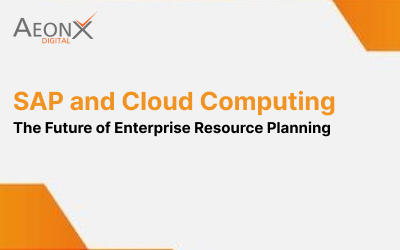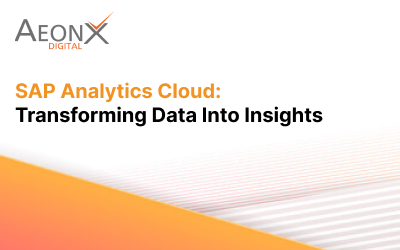
SAP and Cloud Computing: The Future of Enterprise Resource Planning
Introduction
The domain of enterprise resource planning (also known as ERP) solutions is changing rapidly due in no small part to the advent of the cloud.
ERP systems, especially those hosted by the cloud, are progressively winning the hearts and minds of businesses in all industries and walks of life, with the associated benefits such as saving costs, improved scalability, and increased accessibility being identified.
As a century-old player in the platoon of enterprises offering ERP systems, SAP has come to accept this development, especially with services from companies like Amazon Web Services.
The article examines the development towards cloud-based ERP, the benefits of using SAP on infrastructures, and its impact on the way enterprise resource planning will be conducted in the coming years.
Suggested Reading: SAP and Cloud Computing
The Shift Towards Cloud-Based ERP Solutions
Understanding Cloud ERP
Cloud ERP stands for web-based enterprise resource planning software.
Below are the differences in the access of data and software between traditional on-premise systems and ERP solutions.
This shift from on-premise to cloud solutions has changed the way companies do business.
Key Characteristics of Cloud ERP
- Subscription-Based Model: The majority of cloud-based ERP systems are provided on a pay-for-use basis; hence, the users incur costs only for the specific times they utilize them and avoid the steep initial investment costs that come with traditional systems.
- Accessibility: ERP systems can be accessed by their users from any corner of the world with an internet connection, making it easier to work from different locations and bridging the gap between different countries.
- Automatic Updates: Updates and upgrades are managed by vendors, and as a result, the users do not miss out on any new features or security updates that come along without them having to do it manually.
Drivers of the Shift
- Cost Efficiency: In most cases, purchasing and maintaining the tools and apparatus used in traditional ERP systems entails high infrastructural costs. With cloud ERP, most of these costs are reduced, as you pay only for what you use.
- Rapid Deployment: Commonly, business systems based on cloud ERP can be implemented within no time, making it easier for firms to outsource new solutions in a fraction of the time it would have taken to install systems traditionally.
- Flexibility and Agility: The use of it makes it possible for ERP system users to easily modify the systems. This gives room for the operations to be increased or decreased if need be.
The Role of Digital Transformation
The Shift to Cloud-Based ERP has Been Made Possible by Digital Transformation Due to Several Factors.
The contemporary world is witnessing the need to develop and as well improve their operations.
Most of these developments are due to competition and equally changing consumer trends.
Fortunately, Cloud ERP offers support in this change through:
- Real-Time Data Access: With the help of a cloud ERP system, information will easily be available all over the business, which will improve decision-making greatly.
- Integration with Other Cloud Services: Cloud ERP can be easily combined with other applications hosted on the cloud in an enterprise.
- Enhanced Collaboration: Associating geographical locations, which has been an issue especially due to the increase in remote work, cloud ERP supports those teams.
SAP’s Position in Cloud ERP
For many years, SAP has been unrivaled in the field of ERP, creating products for various sectors.
The decision of the company to reorient itself has helped it maintain its leading position in the market as well as bring forth new means of creation.
SAP Cloud Solutions
Over the years, SAP has developed multiple solutions that help businesses today in several aspects:
- SAP S/4HANA: The cloud-based ERP suite allows client organizations to run their operations in real time using different features such as predictive analysis and machine learning.
- SAP Business Technology Platform: This is a combination of a database management system, application development, and intelligence technology that gives clients the ability to create, modify, and link their applications.
- SAP SuccessFactors: As a full-fledged human capital management (HCM) system, SuccessFactors helps organizations get the most from their workforce by improving employees' commitment and performance.
- SAP Ariba: This web-based institutional purchasing system makes it easy to work with active suppliers and improves the management of purchasing activities as well as the supply chain.
Integrating SAP with AWS
The collaboration between SAP and AWS is possibly one of the most fruitful partnerships in cloud computing.
Thanks to the strong and comprehensive infrastructure provided by AWS, this combination improves SAP's solutions.
Benefits of Integrating SAP with AWS
- Scalability and Performance: AWS scale in one way or another comes as ‘Elastic’ capacity management. Such environments capably handle workloads of changing demands.
- Enhanced Security: AWS has always made security its forte with many capabilities such as data encryption, identity and access management, and real-time surveillance, among others.
- Global Reach: AWS has a variety of data centers around the world, making it easy for companies to roll out their strategy and solutions closer to their customers.
- Cost-Effectiveness: AWS comes with affordable services depending on one’s needs. Hence, an organization is able to make better decisions regarding its IT budget.
- Advanced Analytics and Machine Learning: It is well known that AWS is provided with several analytics and machine learning tools that can be used within SAP applications.
Real-World Examples of SAP on AWS
- Siemens: Siemens AG is a global technology company that has migrated its SAP system to the Amazon Web Services (AWS) portal for expedited services and a decrease in costs.
- Coca-Cola: Coca-Cola decided to upgrade incidents of the systems for S/4HANA on AWS in order to improve operations and supervision of the data.
- Unilever: Unilever, a multinational company dealing in fast-moving consumer goods, SAP on AWS is her implementation SAP through the digital transformation program.
- Colgate-Palmolive: Cost containment and increasing operational efficiency informed Colgate Palmolive’s decision to host SAP applications in the AWS.
- 3M: 3M has been using AWS, together with its SAP S/4HANA system, to speed up its digital transformation process.
Advantages of Running SAP on AWS
- Enhanced Flexibility: Embracing SAP applications in the AWS environment allows businesses to remain dynamic in terms of the optimum configurations set for their specific needs.
- Disaster Recovery and Backup: The AWS marketplace has come with brilliant disaster recovery systems that ensure that data is maintained and can be restored in case of any failure.
- Improved Innovation Capabilities: With SAP, AWS helps organizations adopt the latest technological developments, including artificial intelligence (AI), machine learning, and the Internet of Things (IoT).
- Simplified Compliance and Governance: AWS offers a wide range of compliance services to help organizations that are subject to certain regulations.
- Collaborative Ecosystem: AWS promotes and supports an environment where such organizations can integrate and build up various external applications and services without any challenge.
Understand the Benefits of AWS
The Future of SAP and Cloud ERP
Evolving Trends
- Increased adoption of artificial intelligence and machine learning: Information technology is on the verge of integrating new technologies such as AI and machine learning in their enterprise resource planning systems.
- Focus on User Experience: Future ERP systems will emphasize the user experience with easy-to-use screens and features that can be varied at will.
- Multi-Cloud Strategies: Organizations are implementing multiple strategies whereby services from different service providers are integrated to form a digital ecosystem.
- Enhanced Integration Capabilities: The need for the solutions to be integrated will also increase with time.
- Sustainability and Social Responsibility: There will be a strong twist towards more ecologically sustainable solutions and motives.
Strategic Considerations for Businesses
- Assessment of Business Needs: It is important for organizations to carry out a detailed analysis regarding their primary needs and goals in order to be able to choose the right ERP system.
- Change Management: Transitioning to a cloud ERP platform entails a certain level of management of change.
- Vendor Selection: Picking up the correct cloud solution provider is very important.
- Data Migration and Integration: Effective migration to ERP cannot only involve designing the architecture of the applications.
- Continuous Improvement and Optimization: Regular assessment of performance, systems, and user feedback will help the organization justify business engagements.







